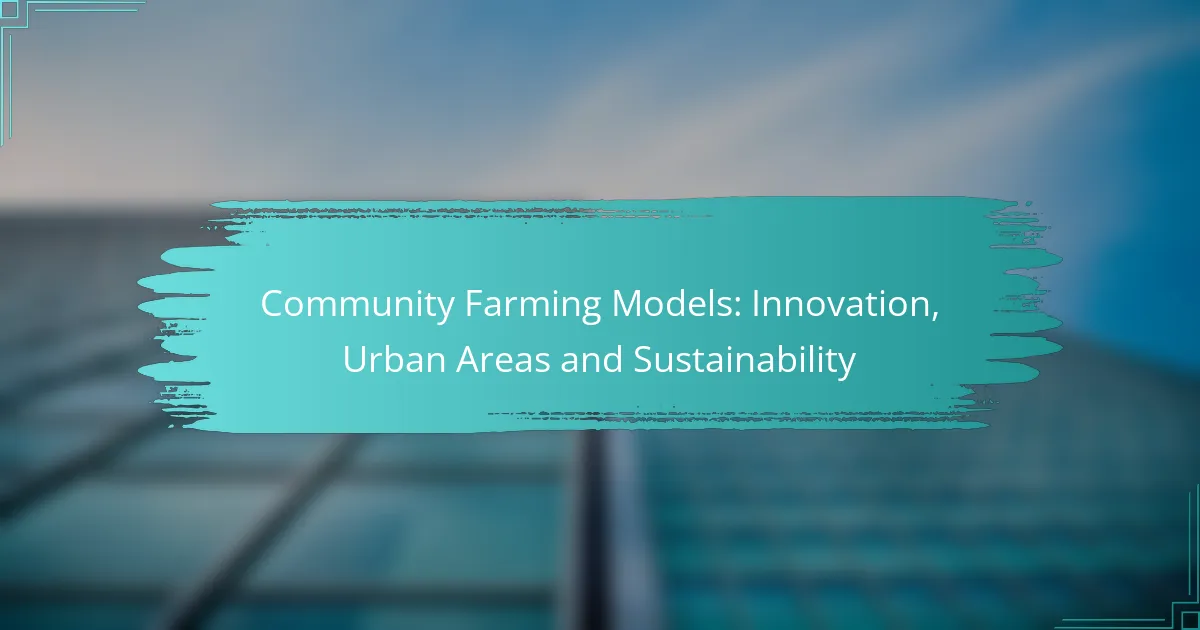Community farming models in urban areas are transforming the way cities approach food production and sustainability. By promoting local agriculture, these initiatives improve access to fresh produce, enhance social connections, and foster environmentally friendly practices. As cities adopt innovative approaches to community farming, they not only address food security but also cultivate resilient urban ecosystems.

What are the benefits of community farming in urban areas?
Community farming in urban areas offers numerous advantages, including improved access to fresh produce, enhanced social cohesion, and a positive impact on the environment. These benefits contribute to healthier lifestyles and stronger community ties.
Improved food security
Community farming enhances food security by providing local access to fresh fruits and vegetables. This reduces reliance on distant food supplies, which can be affected by transportation issues or price fluctuations.
Urban farms can help meet the needs of low-income neighborhoods, where access to affordable, nutritious food is often limited. By growing food locally, these initiatives can significantly increase the availability of fresh produce.
Enhanced community engagement
Community farming fosters social interaction and collaboration among residents. Participants often engage in shared tasks, which helps build relationships and a sense of belonging.
These farms can serve as gathering spaces for workshops, events, and educational programs, further strengthening community ties. Engaging in farming activities also empowers individuals by giving them a stake in their local food system.
Environmental sustainability
Community farming promotes environmental sustainability by utilizing green practices such as organic farming and permaculture. These methods help reduce chemical use and enhance biodiversity in urban settings.
Urban farms can also improve air quality, manage stormwater, and reduce urban heat through increased greenery. By transforming vacant lots into productive spaces, these initiatives contribute to the overall health of the urban ecosystem.

How do community farming models promote sustainability?
Community farming models enhance sustainability by fostering local food production, reducing resource consumption, and encouraging environmentally friendly practices. These models create a network of shared resources and knowledge, which contributes to more resilient urban ecosystems.
Resource conservation
Community farming promotes resource conservation by optimizing the use of land, water, and energy. By utilizing techniques like rainwater harvesting and composting, these farms minimize waste and reduce the need for synthetic fertilizers and pesticides.
For instance, urban farms often employ vertical gardening and hydroponics, which can use up to 90% less water compared to traditional farming methods. This efficient use of resources not only conserves water but also enhances food security in urban areas.
Reduction of carbon footprint
Community farms significantly lower the carbon footprint associated with food production and distribution. By sourcing food locally, these farms reduce the distance food travels, which decreases greenhouse gas emissions from transportation.
Additionally, practices such as organic farming and permaculture further minimize reliance on fossil fuels. For example, using natural pest control methods and crop rotation can lead to healthier soil and reduced carbon emissions, making urban agriculture a more sustainable choice.
Promotion of biodiversity
Community farming plays a crucial role in promoting biodiversity by creating habitats for various species and encouraging diverse plant growth. These farms often incorporate native plants and heirloom varieties, which support local ecosystems and enhance resilience against pests and diseases.
Moreover, community farms can serve as educational platforms, teaching urban residents about the importance of biodiversity. Engaging the community in planting diverse crops not only enriches the local diet but also fosters a deeper connection to the environment.

What are successful examples of community farming in major cities?
Successful community farming initiatives in major cities demonstrate innovative approaches to urban agriculture, fostering sustainability and local food production. These models not only enhance food security but also strengthen community ties and promote environmental stewardship.
Brooklyn Grange in New York City
Brooklyn Grange operates rooftop farms across New York City, utilizing underused urban spaces to grow organic vegetables. Their farms produce over 50,000 pounds of produce annually, which is sold directly to local restaurants and through community-supported agriculture (CSA) programs.
This model emphasizes sustainability by employing organic farming practices and engaging the community through educational programs and volunteer opportunities. Residents can participate in workshops that teach urban farming techniques, fostering a sense of ownership and connection to their food sources.
Urban Roots in Austin
Urban Roots focuses on empowering young people through food and farming in Austin, Texas. Their programs provide hands-on training in sustainable agriculture while producing fresh produce for local food pantries and markets. This initiative not only addresses food insecurity but also cultivates leadership skills among participants.
Urban Roots operates a 3.5-acre farm where they grow a variety of vegetables, herbs, and flowers. They also run educational programs that reach thousands of students, teaching them about nutrition and the importance of local food systems.
City Farm in Chicago
City Farm is a nonprofit urban farm located in Chicago that transforms vacant lots into productive green spaces. They grow a diverse range of organic vegetables and herbs, which are sold at local farmers’ markets and through a CSA program. This initiative helps revitalize neighborhoods while providing fresh produce to underserved communities.
City Farm emphasizes community involvement by offering volunteer opportunities and educational workshops. These programs teach residents about sustainable farming practices and the benefits of local food production, fostering a stronger community connection and awareness of food systems.

What are the challenges of implementing community farming?
Implementing community farming faces several challenges, including land access, funding, and community engagement. These obstacles can hinder the establishment and sustainability of urban agriculture initiatives.
Land access and zoning issues
Securing land for community farming is often complicated by zoning regulations and property rights. Many urban areas have strict zoning laws that may not permit agricultural activities, limiting potential sites for community gardens or farms.
Additionally, high land costs in urban settings can make it difficult for community groups to acquire or lease suitable plots. Collaborating with local governments to identify underutilized public lands can be a viable solution.
Funding and resource allocation
Funding is a critical challenge for community farming projects, as they often rely on grants, donations, or community fundraising. Establishing a clear budget and identifying potential funding sources, such as local businesses or non-profits, can help secure necessary resources.
Resource allocation also plays a role; community farms need tools, seeds, and educational materials. Creating partnerships with local agricultural organizations can provide access to these resources at reduced costs or through donations.
Community involvement and education
Engaging the community is essential for the success of community farming. Without active participation, projects may struggle to thrive. Organizing workshops and events can foster interest and encourage local residents to contribute their time and skills.
Education about sustainable farming practices is equally important. Providing training sessions on gardening techniques and the benefits of local food systems can empower community members and enhance their commitment to the project.

How can urban planners support community farming initiatives?
Urban planners can support community farming initiatives by creating favorable policies, fostering partnerships, and integrating these projects into broader urban development plans. This approach not only enhances food security but also promotes sustainability and community engagement in urban areas.
Policy development and incentives
Effective policy development is crucial for the success of community farming initiatives. Urban planners should advocate for zoning regulations that allow for agricultural activities in urban settings and provide incentives such as tax breaks or grants for community gardens and urban farms.
Incentives can also include access to land at reduced rates or funding for infrastructure improvements. For example, cities like Portland have implemented policies that support urban agriculture through streamlined permitting processes and financial assistance programs.
Partnerships with local organizations
Building partnerships with local organizations is essential for the sustainability of community farming. Urban planners should collaborate with non-profits, schools, and local businesses to create a network that supports these initiatives through resources, expertise, and volunteer efforts.
For instance, a partnership between a city and a local food bank can enhance food distribution from community farms to underserved populations, creating a win-win situation for both parties. Engaging local stakeholders ensures that the farming initiatives are tailored to the community’s needs and strengths.
Integration into urban development plans
Integrating community farming into urban development plans ensures that these initiatives are considered in the long-term vision of the city. Urban planners should include community gardens and urban farms in land use plans, transportation networks, and public space designs.
For example, incorporating green spaces that feature community farms in new residential developments can enhance property values and improve residents’ quality of life. Planners should also consider how these farms can contribute to urban biodiversity and climate resilience, making them a vital part of sustainable urban growth.

What are the key factors for successful community farming models?
Successful community farming models hinge on effective collaboration, resource accessibility, and sustainable practices. These elements foster a thriving environment where local communities can engage in agriculture while promoting environmental stewardship and food security.
Community involvement
Community involvement is crucial for the sustainability of farming models. Engaging local residents in decision-making processes ensures that the farming initiatives reflect their needs and preferences. This can be achieved through regular meetings, workshops, and volunteer days that encourage participation.
Building a strong sense of community can enhance commitment and support for the farming project. For instance, organizing events such as harvest festivals or farm-to-table dinners can strengthen bonds among participants and attract new members.
Access to resources
Access to resources, including land, funding, and educational materials, is essential for the success of community farming. Communities should explore partnerships with local governments, non-profits, and businesses to secure grants or donations that can help cover initial costs and ongoing expenses.
Additionally, providing training and workshops on sustainable farming techniques can empower community members with the knowledge they need to manage their farms effectively. Resources such as soil testing services, seed banks, and shared equipment can also enhance productivity and reduce costs.
